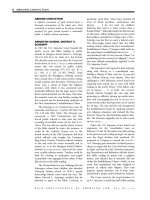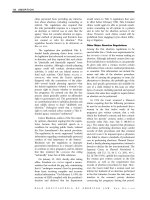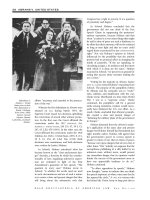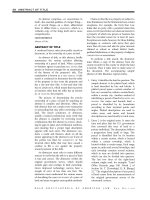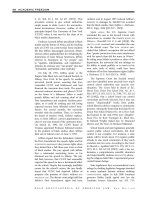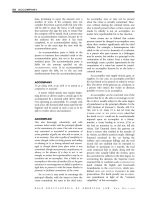Gale Encyclopedia Of American Law 3Rd Edition Volume 1 P2 docx
Bạn đang xem bản rút gọn của tài liệu. Xem và tải ngay bản đầy đủ của tài liệu tại đây (956.46 KB, 10 trang )
k
How to Use This
Book
1
1
2
4
3
2
3
4
5
6
7
8
9
10
11
12
13
XIII
5
6
7
9
10
13
12
11
8
GALE ENCYCLOPEDIA OF AMERICAN LAW, 3RD E DITION
XIV HOW TO USE THIS BOOK
Contributors
Editorial Reviewers
Patricia B. Brecht
Matthew C. Cordon
Frederick K. Grittner
Halle Butler Hara
Scott D. Slick
Contributing Authors
Richard Abowitz
Paul Bard
Joanne Bergum
Michael Bernard
Gregory A. Borchard
Susan Buie
James Cahoy
Terry Carter
Stacey Chamberlin
Sally Chatelaine
Joanne Smestad Claussen
Matthew C. Cordon
Richard J. Cretan
Lynne Crist
Paul D. Daggett
Susan L. Dalhed
Lisa M. DelFiacco
Suzanne Paul Dell’Oro
Heidi Denler
Dan DeVoe
Joanne Engelking
Mark D. Engsberg
Karl Finley
Sharon Fischlowitz
Jonathan Flanders
Lisa Florey
Robert A. Frame
John E. Gisselquist
Russell L. Gray III
Frederick K. Grittner
Victoria L. Handler
Halle Butler Hara
Lauri R. Harding
Heidi L. Headlee
James Heidberg
Clifford P. Hooker
Marianne Ashley Jerpbak
David R. Johnstone
Andrew Kass
Margaret Anderson Kelliher
Christopher J. Kennedy
Anne E. Kevlin
John K. Krol
Lauren Kushkin
Ann T. Laughlin
Laura Ledsworth-Wang
Linda Lincoln
Theresa J. Lippert
Gregory Luce
David Luiken
Frances T. Lynch
Jennifer Marsh
George A. Milite
Melodie Monahan
Sandra M. Olson
Anne Larsen Olstad
William Ostrem
Lauren Pacel li
Randolph C. Park
Gary Peter
Michele A. Potts
Reinhard Priester
Christy Rain
Brian Roberts
Debra J. Rosenthal
Mary Lahr Schier
Mary Scarbrough
Stephanie Schmitt
Theresa L. Schulz
John Scobey
Kelle Sisung
James Slavicek
Scott D. Slick
David Strom
Linda Tashbook
Wendy Tien
M. Uri Toch
Douglas Tueting
Richard F. Tyson
Christine Ver Ploeg
George E. Warner
Anne Welsbacher
Eric P. Wind
Lindy T. Yokanovich
XV
A FORTIORI
[Latin, With stronger reason.] This phrase is used
in logic to denote an argument to the effect that
because one ascertained fact exists, therefore
another whi ch is included in it or analogous to
it and is less improbable, unusual, or surprising
must also exist.
A MENSA ET THORO
[Latin, From table and bed, but more commonly
translated as “from bed and board.”] This phrase
designates a
DIVORCE which is really akin to a
SEPARATION granted by a court whereby a
HUSBAND AND WIFE are not legally obligated to live
together, but their
MARRIAGE has not been
dissolved. Neither spouse has the right to remarry
where there is a divorce a mensa et thoro; only
parties who have been awarded a divorce a
vinculo matrimonii, the more common type of
divorce, can do so.
A POSTERIORI
[Latin, From the effect to the cause.] A posteriori
describes a method of reasoning from given,
express observations or experiments to reach and
formulate general principles from them. This is
also called inductive reasoning.
A PRIORI
[Latin, From the cause to the effect.] This phrase
refers to a type of reasoning that examines given
general principles to discover what particular facts
or real-life observations can be derived from them.
Another name for this method is deductive
reasoning.
AB INITIO
[Latin, From the beginning; from the first act;
from the inception.] An agreement is said to be
“void ab initio” if it has at no time had any legal
validity. A party may be said to be a trespasser, an
estate said to be good, an agreement or deed said
to be void, or a marriage or act said to be
unlawful, ab initio. Contrasted in this sense with
ex post facto, or with postea.
The illegality of the conduct or the revela-
tion of the real facts makes the entire situation
illegal ab initio (from the beginning), not just
from the time the wrongful behavior oc curs. A
person who enters property under the authority
of law but who then by misconduct abuses his
or her right to be on the property is considered
a trespasser ab initio. If a sheriff enters property
under the authority of a court order requiring
him to seize a valuable painting, but instead he
takes an expensive marble sculpture, he would
be a trespasser from the beginning. Because the
officer abused his authority, a court would
presume that he intended from the outset to use
that authority as a cloak from under which to
enter the property for a wrongful purpose. This
theory, used to correct abuses by public officers,
has largely fallen into disuse.
A
1
ABANDONMENT
The surrender, relinquishment, disclaimer, or
cession of property or of rights. Voluntary
relinquishment of all right, title, claim, and
possession, with the intention of not reclaiming it.
In the case of children, abandonment is the willful
forsaking or forgoing of parental duties. Desertion as a
legal concept, is s imilar in this respect, although
broader in scope, c overing both real and constructive
situations; abandonment is generally seen as involv-
ing a specific and tangible forsaking or forgoi ng.
Property That Can Be Abandoned
Various types of personal property—such as
personal and household items—contracts, copy-
rights, inventions, and
PATENTS can be aban-
doned. Certain rights and interests in real
property, such as easements and leases, may also
be abandoned. Suppose a ranch owner, for
example, gives a shepherd an easement to use a
path on her property so that the sheep can get to
a watering hole. The shepherd later sells his flock
and moves out of the state, never intending
to return. This c onduct demonstrates that
the shepherd has abandoned the easement, because
he stopped using the path and intends never to
use it again. Ownership of real property cannot
be obtained because someone else abandoned it
but may be gained through
ADVERSE POSSESSION.
Elements of Abandonment
Two things must occur for property to be
abandoned: (1) an act by the owner that clearly
shows that he or she has given up rights to the
property; and (2) an intention that demon-
strates that the owner has knowingly relin-
quished contro l over it.
Some clear action must be taken to indicate
that the owner no longer wants his or her
property. Any act is sufficient as long as the
property is left free and open to anyone who
comes along to claim it. Inaction—that is,
failure to do something with the property or
nonuse of it—is not enough to demonstrate
that the owner has relinquished rights to the
property, even if such nonuse has gone on for a
number of years. A farmer’s failure to cultivate
his or her land or a quarry owner’s failure to
take stone from his or her quarry, for example,
does not mean that either person has aban-
doned interest in the property.
Aperson’s intention to abandon his or her
property may be established by express language
to that effect or it may be implied from the
circumstances surrounding the owner’s treatment
of the property, such as leaving it unguarded
in a p l ace eas ily ac c essible to the public. The
passage of time, although not an element of
abandonment, may illustrate a person’sintention
to abandon his or her property.
Parental Abandonment of Children
Parental abandonment of child ren is different
from other cases of abandonment in that it
involves a person rather than property. Aban-
donment of children is a criminal
CAUSE OF
ACTION
under most state laws. In the civil
context, it arises when a court decides to
terminate the natural rights of the parent on
the grounds of abandonment to allow
ADOPTION.
In a criminal context, abandonment of
children is defined as actually abandoning a
child, or failing to provide necessities of living
to a child. In California, for example, a parent is
guilty of abandonment if they fail to provide
“necessary clothing, food, shelter or medical
attendance, or other remedial care for their
child.” A parent is required to accept their minor
child into their home, or provide alternative
shelter. Parents in California are also punished
for “desertion with intent to abandon.” These
laws are typical of most states.
In the late 1990s the issue of baby abandon-
ment in the United States came to a head as a
result of several high profile cases. These cases
prompted 38 states to pass so-called “safe haven
laws.” The laws decriminalize baby abandonment
by allowing mothers to leave their unharmed
babies at a designated “safe.” location s uch as a
hospital, fire s tation, o r licensed child-placing
agency. The laws include a time frame, beginning
from the baby’s birth, in which abandonment
may take place; the time frame varies from state to
state, ranging from 72 hours up to one year.
In a civil context, abandonment of a child is
usually ruled on by a court to facilitate an
adoption. State Courts employ various guide-
lines to determine if a child has been aban-
doned. In an action for adoption on the ground
of abandonment, the
PETITIONER generally must
establish conduct by the child’s natural parent
or parents that shows neglect or disregard of
parental duties, obligations, or responsibilities.
They must also show an intent by the child’s
parent or parents to permanently avoid parental
duties, obligations, or responsibilities. Some
GALE ENCYCLOPEDIA OF AMERICAN LAW, 3RD E DITION
2 ABANDONMENT
jurisdictions require an actual intention of the
parents to relinquish their rights to find
abandonment, but most allow a finding of
abandonment regardless of whether the parents
intended to extinguish their rights to the child.
FURTHER READINGS
Brunette, Stephen A. 2001. Cause of Action for Adoption
without Consent of Parent on Ground of Abandonment.
Causes of Action Series, 1st ser. Eagan, MN: West.
Magnusen, Debbie. 2001–02. “From Dumpster to Delivery
Room: Does Legalizing Baby Abandonment Really
Solve the Problem?” Journal of Juvenile Law 22.
Vassilian, Karen. 2000–2001. “A Band-Aid or a Solution?
Child Abandonment Laws in California.” McGeorge
Law Review 32.
CROSS REFERENCE
Desertion.
ABATEMENT
A reduction, a decrease, or a diminution. The
suspension or cessation, in whole or in part, of a
continuing charge, such as rent.
With respect to estates, an abatement is a
proportional diminution or reduction of the
monetary legacies, a disposition of property by
will, when the funds or assets out of which such
legacies are payable are insufficient to pay them
in full. The intention of the
TESTATOR, when
expressed in the will, governs the order in which
property will abate. Where the will is silent,
abatement occurs in the following order:
INTESTATE property, gifts that pass by the
RESIDUARY CLAUSE in the will, general legacies,
and specific legacies.
In the context of
TAXATION, an abatement is a
decrease in the amount of tax imposed.
Abatement of taxes relieves property of its share
of the burdens of taxation after the
ASSESSMENT
has been made and the LEVY of the tax has been
accomplished.
CROSS REFERENCES
Taxation; Will.
ABATEMENT OF AN ACTION
An entire overthrow or destruction of a suit so that
it is quashed and ended.
The purpose of
ABATEMENT is to save the time
and expense of a trial when the plaintiff’s suit
cannot be maintained in the form originally
presented. After an action abates, the
PLAINTIFF is
ordinarily given an opportunity to correct
errors in his or her
PLEADING. If the plaintiff still
is unable to ALLEGE the facts necessary to state a
legal
CAUSE OF ACTION, then the action is
terminated.
Not every possible reason for dissatisfaction
with another person can be heard by a court.
When the old
COMMON LAW form of action
governed the procedure followed by courts (as
opposed to state and federal rules of procedure,
which now do), only legal wrongs that fit
exactly into one of the allowed categories could
be pleaded in court. If the
DEFENDANT believed
that the plaintiff’s complaint did not fit one of
these fo rms, the defendant could respond with a
PLEA IN ABATEMENT.APLEA in abatement was
called a
DILATORY PLEA because it delayed the time
when the court would reach the merits of the
plaintiff’s
CLAIM, if ever.
The rigid formality of common law plead-
ing bec ame less satisfactory as legal disputes
became more complicated. It has been replaced
in each state by a procedure that allows the
plaintiff to plead f acts showing his or her right
to legal relief. Modern systems of pleading
retain a right for the defendant to seek
abatement of the action when the plaintiff is
not entitled to be in court. They allow a
defendant to object to the court’sjurisdiction,
the venue of the trial, the sufficiency of
process, or of the
SERVICE OF PROCESS,thelegal
sufficiency of the plaintiff’s claim, or the f ailure
to include someone who must be a party. A
plea in abatement is made either in the
defendant’sanswerorby
MOTION and order—
that is, an application to the court for relief and
an order that c an grant it. Abatement is usually
granted in the form of a dismissal of cause of
action, and now the term dismissal is used
more often than the te rm abatement for this
procedure.
In the early twenty-first century, the word
abatement is most often used for the termina-
tion of a lawsuit because of the death of a party.
Under the common law, a lawsuit abated
automatically whenever a party died. This rule
was considered a part of the substance of the
law involved and was not merely a question of
procedure. Whether the cause of action abated
depended on whether or not the lawsuit was
considered personal to the parties. For example,
contract and property cases were thought to
involve issues separate from the parties them-
selves. They were not personal and did not
necessarily abate on the death of a party.
GALE ENCYCLOPEDIA OF AMERICAN LAW, 3RD E DITION
ABATEMENT OF AN ACTION 3
PERSONAL INJURY cases were co nsidered personal,
however, and did abate at death. These included
claims not only for physical
ASSAULT or negligent
injuries inflicted on the body, but also for other
injuries to the person—such as libel, slander,
and
MALICIOUS PROSECUTION.
There are statutes that permit the
REVIVAL OF
AN ACTION
that was pending when a party died.
An executor or administrator is substituted for
the deceased party and the lawsuit continues. A
lawsuit may not be revived unless the underly-
ing cause of action, the ground for the suit,
continues to have a legal existence after the
party’s death. Revival statutes vary from state to
state, but today most lawsuits do not abate.
This general rule does not apply to matrimo-
nial actions. A lawsuit for
DIVORCE or SEPARATION
is considered entirely personal and therefore
cannot be maintained after the death of a party.
Different states do make exceptions to this rule
in order to settle certain questions of property
ownership. An action for the
ANNULMENT of a
MARRIAGE after the death of an innocent spouse
may be revived by the deceased spouse’s
PERSONAL
REPRESENTATIVE
if it is clear that the marriage was
induced by
FRAUD and the PERPETRATOR of the
fraud would inherit property to which he or she
would otherwise not be entitled.
v
ABBOTT, BENJAMIN VAUGHN
Benjamin Vaughn Abbott was born June 4,
1830, in Boston, Massachusetts. He graduated
from New York University in 1850 and was
admitted to the New York bar in 1852.
From 1855 to 1870 Abbott, in collaboration
with his brother Austin, wrote a series of law
treatises and reports, including Digest of New
York Statutes and Reports (1860). The series led
to Abbott’s New York Digest, the most recent
series of which has been renamed West’s New
York Digest 4th.
In 1864 Abbott became secretary of the New
York Code Commission and was instrumental
in the formulation of the New York
PENAL Code,
much of which is still in use.
From 1870 to 1872 he served as a commis-
sioner to amend the statutes of the United States.
Abbott died February 17, 1890, in Brooklyn,
New York.
As an author, Abbott wrote several publica-
tions, including Judge and Jury (1880); The
Travelling Law School (1884); and Addison on
Contracts (1888).
ABDICATION
Renunciation of the privileges and prerogatives of
an office. The act of a sovereign in renouncing and
relinquishing his or her government or throne, so
that either the throne is left entirely vacant, or is
filled by a successor appointed or elected before-
hand. Also, where a magistrate or person in office
voluntarily renounces or gives it up before the time
of service has expired. It differs from resignation, in
that resignation is made by one who has received an
office from another and restores it into that person’s
hands, as an inferior into the hands of a superior;
abdication is the relinquishment of an office that
has devolved by act of law. It is said to be a
renunciation, quitting, and relinquishing, so as to
have nothing further to do with a thing, or the
doing of such actions as are inconsistent with the
holding of it. Voluntary and permanent withdraw-
al from power by a public official or monarch.
The difference between abdicating a posi-
tion and resigning one lies primarily in the
irrevocability of abdication. Once an office or
throne is abdicated, a return is not legally
Benjamin Vaughn Abbott 1830–1890
❖
◆
◆
◆
◆◆❖
1830 Born,
Boston,
Mass.
1850 Graduated from New
York University
1852 Admitted to
New York bar
1860 Published Digest of New York Statutes and
Reports (with brother Austin)
1861–65
U.S. Civil War
1870–72 Served as
commissioner to
amend United States
statutes
1864 Became secretary of NY Code Commission,
helped formulate penal code
1880
Published
Judge and
Jury
1888 Published
Addison on Contracts
1890 Died
▼▼
▼▼
18251825
19001900
18751875
18501850
◆
GALE ENCYCLOPEDIA OF AMERICAN LAW, 3RD E DITION
4 ABBOTT, BENJAMIN VAUGHN
possible. Unlike resignation, abdication is not a
matter of the relinquishment of a position to an
employer or a superior. Instead, it is the
ABSOLUTE
and final RENUNCIATION of an office created
specifically by an act of law. After an abdication,
the office remains vacant until a successor is
named by appointment or election.
An early example of royal abdication
occurred in 305
A.D., when the Roman emperor
Diocletian withdrew from power after suffering
a serious illness. Another sovereign, King Louis
Philippe of France (the Citizen King), abdicated
on February 24, 1848, because of public hostility
toward the monarchy.
Perhaps the most famous abdication of
power occurred on December 11, 1936, when
England’s King Edward VIII (1894–1972) re-
nounced his throne in order to marry Wallis
Warfield Simpson (1896–1986). Simpson was a
twice-divorced socialite whose rocky
MARITAL
history and American citizenship made her an
unacceptable choice as wife of the British
monarch. The affair between Edward and
Simpson created an international scandal because
it began well before her second
DIVORCE was
finalized. Edward’s ministers pleaded with him to
sever his relationship with the woman, whom his
mother, Queen Mary, dismissed as “the American
adventuress.” Edward could not remain king and
head of the Church of England if he married
Simpson, because of the church’s opposition to
divorce. Unhappy with many of his royal duties
and transfixed by Simpson, Edward chose to
renounce the monarchy and marry her.
On December 11, 1936, Edward announced
his decision at Fort Belvidere, his private estate
six miles from Windsor Castle. There he signed
an instrument of abdication and conducted a
farewell radio broadcast in which he told his
subjects that he relinquished the throne for “the
woman I love.” The 42-year-old royal, who had
ascended the throne on January 20, 1936, upon
the death of his father, King George V, was
succeeded by his younger brother, the duke of
York, who became King George VI, father of
Queen Elizabeth II.
Edward and Simpson were married in Paris
on June 3, 1937. Afterward, the former sover-
eign and his wife were addressed as the duke
and duchess of Windsor. Except for a period
during
WORLD WAR II spent in colonial Bahamas,
the couple resided in royal exile in Paris for
most of their nearly 35-year
MARRIAGE.
FURTHER READINGS
Thornton, Michael. 1985. Royal Feud: The Dark Side of the
Love Story of the Century. New York: Simon & Schuster.
Warwick, Christopher. 1985. Abdication. London: Sidgwick &
Jackson.
Williams, Douglas R. 2000. “Congressional Abdication,
Legal Theory, and Deliberative Democracy.” Saint Louis
Univ. Public Law Review 19 (summer).
ABDUCTION
The act of restraining another through the use or
threat of deadly force or through fraudulent
persuasion. The requisite restraint generally
requires that the abductor intend to prevent the
liberation of the abductee. Some states require that
the abductee be a minor or that the abd uctor
intend to subject the abductee to prostitution or
illicit sexual activity.
CROSS REFERENCE
Kidnapping.
v
ABERNATHY, RALPH DAVID
In the long battle for CIVIL RIGHTS, few leaders
have had as an important a role as Ralph David
Abernathy. From the late 1950s until 1968,
Abernathy was the right-hand man of
MARTIN
The abdication
document signed on
December 10, 1936,
by King Edward VIII
and his brothers,
Albert, Henry, and
George.
AP IMAGES
GALE ENCYCLOPEDIA OF AMERICAN LAW, 3
RD E DITION
ABERNATHY, RALPH DAVID 5
LUTHER KING Jr. Together in 1957 they founded
the
SOUTHERN CHRISTIAN LEADERSHIP CONFERENCE
(SCLC), the organization chiefly responsible for
the nonviolent
PROTEST movement whose gains
over the next decade included major legal and
social reforms for black Americans. Abernathy
oftensharedaplacenexttoKinginmeetings,
marches, and jail, yet despite his considerable
contributions to the
CIVIL RIGHTS MOVEMENT,
he labored largely in King’s shadow. Later
becoming SCLC pr esident, he watched the
transformation of the movement as his influence
weakened and his politics changed, until contro-
versy ultimately divided him from its mainstream.
Born on March 11, 1926, in Marengo County,
Alabama, Abernathy was the grandson of a slave.
His family members were successful farmers, and
his father’s leadership in the county’sblack
community inspired him. Upon graduating from
Linden Academy, he served in the army in
WORLD
WAR II
. He was ordained as a Baptist minister in
1948. He earned a B.A. in mathematics from
Alabama State College in 1950, an M.A. in
sociology from Atlanta University in 1951, and
later a law degree from Allen University in 1960.
The defining moment in Abernathy’s life
was meeting King. As a student in Atlanta, he
had heard King preach in church. From there,
they began a friendship that would shape both
men’s futures. In 1955, while both were pastors
in Montgomery, Alabama, they began the first of
many local protest actions against racial
DISCRIM-
INATION
. They organized a BOYCOTT of city buses
by black passengers that led to the successful
desegregation of local bus lines one year later.
To build on this triumph, the pastors called a
meeting of black leaders from ten southern states
in January 1957 at an Atlanta church. This
meeting marked the founding of the SCLC, which
was devoted to the goal of furthering civil rights
throughout the south. King was appointed the
group’s president, Abernathy its secretary-trea-
surer. The civil rights movement had begun.
Although the SCLC had committed itself to
nonviolent protest, the forces they opposed
were far from gun-shy. Segregationists bombed
Abernathy’s home and church. As opp osition
from individuals as well as government and law
enforcement mounted, Abernathy continued to
stress nonviolence. He said, “violence is the
weapon of the weak and nonviolence is the
weapon of the strong. It’s the job of the state
troopers to use mace on us. It’s our job to keep
marching. It’s their job to put us in jail. It’s our
job to be in jail.”
Ralph Abernathy.
BETTMANN/CORBIS.
Ralph David Abernathy 1926–1990
▼▼
▼▼
19251925
20002000
19751975
19501950
❖
❖
◆
◆◆
◆◆
◆
◆
1990 Died,
Atlanta, Ga.
1989
Memoir
published
1977 Forced from
leadership of SCLC
amid a feud with
Coretta Scott King
1968
Became
SCLC
president
1957 Helped
found SCLC
1948
Ordained
Baptist
minister
1926 Born in
Marengo
County, Ala.
1960 Earned law degree
from Allen University
1939–45
World War II
1955–56
Montgomery
Bus Boycott
1968 Martin Luther
King Jr. assassinated
I DON’T KNOW WHAT
THE FUTURE MAY
HOLD
, BUT I KNOW
WHO HOLDS THE
FUTURE
.
—RALPH ABERNATHY
GALE ENCYCLOPEDIA OF AMERICAN LAW, 3RD E DITION
6 ABERNATHY, RALPH DAVID
For nearly a decade, this philosophy was a
clarion call answered by thousands. Through sit-
down strikes, marches, arrests and jailings, and
frequently at great personal danger, King and
Abernathy led a mass of nonviolent protesters
across the south, working together to devise
strategy and put it into action. The enactment of
federal civil rights
LEGISLATION in 1964 marked a
major success. But tragedy followed with King’s
ASSASSINATION in May 1968, after which Abernathy
replaced him as SCLC president. He now added a
new aggressiveness to the group’s goals, notably
organizing a week-long occupation of Potomac
Park in Washington, D.C., by five thousand
impoverished tent-dwellers in what was called the
Poor People’s Campaign. This effort to dramatize
poverty was quickly crushed by federal law
enforcement.
By the end of the 1960s, Abernathy’s
influence was in decline. The civil rights
movement had splintered as younger, more
militant members gravitated toward groups
such as the Black Panthers and the Committee
on Racial Equality (CORE). In 1977 Abernathy
was forced from leadership of the SCLC amid a
feud with King’s widow, Coretta Scott King, and
made an unsuccessful bid for Congress. In
1980, he supported the presidential campaign of
conservative Republican
RONALD REAGAN, which
further divided him from former friends and
associates. References to Martin Luther King Jr.’s
MARITAL infidelities in Abernathy’s 1989 memoir
And the Walls Came Tumbling Down provoked
more criticism. Politically and personally isolat-
ed, Abernathy died one year later of a heart attack
on April 17, 1990, at the age of 64. In death,
however, the criticism faded and was replaced by
praise for his contributions to civil rights.
CROSS REFERENCES
Civil Rights Movement; King, Martin Luther, Jr.; Southern
Christian Leadership Conference.
ABET
To encourage or incite another to commit a crim e.
This word is usually applied to aiding in the
commission of a crime. To abet another to commit
a murder is to co mmand, procure, counsel,
encourage, induce, or assist. To facilitate the
commission of a crime, promote its accomplish-
ment, or help in advancing or bringing it about.
In relation to charge of aiding and abetting,
term includes knowledge of the perpetrator's
wrongful purpose, and encouragement, promotion
or counsel of another in the commission of the
criminal offense.
A French word, abeter—to bait or excite an
animal.
For example, the manager of a jewelry store
fails to turn on the store’s silent alarm on the
night she knows her cousin plans to rob the
store. Her conduct is that of abetting the
ROBBERY.
If, however, she merely forgot to turn on the
alarm, she would not have abetted the crime.
The word abet is most commonly used as
part of the comprehensive phrase
AID AND ABET.
ABETTOR
One who commands, advises, instigates, or
encourages another to commit a crime. A person
who, being present, incites another to commit a
crime, and thus becomes a principal. To be an
abettor, the accused must have instigated or
advised the commission of a crime or been present
for the purpose of assisting in its commission; he or
she must share criminal intent with which the
crime was committed.
A person who lends a friend a car for use in
a
ROBBERY is an abettor even though he or she is
not present when the robbery takes place. An
abettor is not the chief actor, the principal, in
the commission of a crime but must share the
principal’s criminal intent in order to be
prosecuted for the same crime.
ABEYANCE
A lapse in succession during which there is no person
in whom title is vested. In the law of estates, the
condition of a freehold when there is no person in
whom it is vested. In such cases the freehold has been
said to be in nubibus (in the clouds), in pendenti
(in suspension);andin gremio legis (in the bosom
of the law). Where there is a tenant of the freehold,
the remainder or reversion in fee may exist for a time
without any particular owner, in which case it is said
to be in abeyance. A condition of being undeter-
mined or in state of suspension or inactivity. In
regard to sales to third parties of property acquired
by county at tax sale, being held in abeyance means
that certain rights or conditions are in expectancy.
For example, until an order of
FORECLOSURE is
granted by a court, a mortgagee does not have title
to the property of a delinquent debtor that is the
subject of a
MORTGAGE in those jurisdictions that
follow the
LIEN theory of mortgages.
GALE ENCYCLOPEDIA OF AMERICAN LAW, 3RD E DITION
ABEYANCE 7



